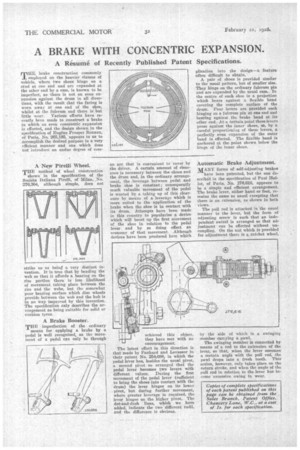A BRAKE WITH CONCENTRIC EXPANSION.
Page 70

If you've noticed an error in this article please click here to report it so we can fix it.
A Resume of Recently Published Patent Specifications.
MHE brake construction eonurionly
employed on the heavier classes of vehicle, where two shoes hinge on a stud at one end and are expanded at the other end by a cam, is known to be imperfect, as there is not an even expansion against the drum in all directions, with the result that the facing is worn away at one end of the shoe, whilst at the fulcrum end there is but little wear. Various efforts have recently been made to construct a brake in which an even concentric .expansion is effected, and the design shown in the specification of Eugene Prosper Renaux, of Paris, No. 265,195, appears to us to accomplish the desired purpose in a very efficient manner and one which does not introduce an undue degree of corn • A New Pirelli Wheel.
THE method of wheel construction shown in the specification of the Societe Italiana Pirelli, of Milan, ,No. 276,304, although simple, does not
strike us as being a very distinct invention. It is true that by bending the web so that it affords a bearing on the rim portion there is less likelihood of movement taking place between the rim and the webs, but the somewhat poor bearing surface which disc wheels provide between the web and the huh is in no Way improved by this invention. The specification only describes the arrangement as being suitable for solid or cushion tyres.
A Brake Booster.
THE imperfection of the ordinary means for applying a brake by a Pedal is well recognized, as the movement of a pedal can only be through an are that is convenient to cover by the driver. A certain amount of clearance is necessary between the shoes and the drum and, in the ordinary arrangement, the •leverage between pedal and brake shoe is constant; consequently much valuable movement of the pedal is wasted by a .taking up of this clearwilco by means of a leverage which is more suited to the• application of the brake when tho shoe is in contact with its drum. Attempts have been made in this country to popularize a device which will boost up the first movement of the shoe in relation to the pedal lever and by so doing effect an economy of that movement. Although devices have been produced here which
achieved this object, they have met with no encouragement.
The latest effort in this direction is that made by Panhard and Levassor in their patent No. 254,698, in which the pedal lever has, besides the usual pivot, a second pivot so arranged that the pedal lever becomes two levers with different values. During the first movement of the pedal lever (sufficient to bring the shoes into contact with the drum) the lever binges on its lower pivot, but during further movement, where greater leverage is required, the lever hinges on the higher pivot. The dot-and-dash lines, which we have added, indicate the to different radii, and the difference is obvious.
plication into the design—a feature often difficult to obtain.
A pair of shoes is provided similar to the usual pattern, but of smaller size. They hinge on the ordinary fulcrum pin and are expanded by the usual earn.. In the centre of each shoe is a projection which bears against a flexible band covering the complete surface of the drum. Four levers are provided each hinging on a fulcrum pin at one end and bearing against the brake band at its other end. At a certain point these levers press against the inner shoes, so, by a careful proportioning of these levers, a perfectly even expansion of the outer band is effected. The flexible band is anchored at the point shown below the hinge of the inner shoes.
Automatic Brake Adjustment.
MANY forms of self-adjusting brakes
have been patented, bat the one described in the specification of Paul Hallot, of Paris, No. 276,616, appears to be a simple and efficient arrangement. The brake lever, either hand or foot, remains the same as usual excepting that there is au extension, as shown in both views.
The pull rod is attached in the usual manner to the .lever, but the form of adjusting screw is such that an independent swivel is arranged so that adjustment can be effected without uncoupling. On the nut which is provided for adjustment there is a ratchet wheel,
by the side of which is a swinging member Carrying a pawl.
The swinging member is connected by means of a rod to the extension of the lever, so that, when the lever assumes a certain angle with the pull rod, the pawl drops into a fresh tooth. This action, however, only takes place on the return stroke, and when the angle of the pull rod in relation to the lever has become 'excessive owing to wear.












































































































